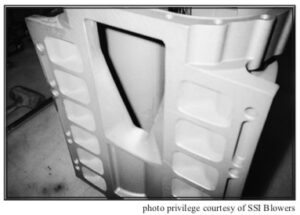Roots blowers are popular in motorsports for making more power. They are made up of a simple blower case with two rotors inside. The rotors spin from an engine driven blower drive. This pumps extra air into the engine. With extra air and the appropriate extra fuel, extra power!
The blower case design was changed in later years to improve performance. One of these areas is the size of the blower case discharge opening.
Original Roots blowers ran on industrial engines. They were simple mass flow devices running at atmospheric pressure. In the mid 19th century, motorsports racers put them on racing engines. They pumped a lot more air into the engine causing boost. This became an easy way to make more power.
However, because they were originally designed to operate at atmospheric pressure, they were inefficient with boost. While they made more power, it was not that much more for the amount of increased air into the engine.
One of the design areas affecting efficiency is the blower case discharge opening. That is discussed in several of our publications. Here are two examples:
Blower outlet size
Another contribution to blower efficiency is the size of the blower case bottom opening. Standard Roots blowers use a relatively large opening. As each rotor turns towards the bottom, the contents in the lobe cavity are opened to the intake manifold. The lobe cavity contents are essentially at atmospheric pressure. The intake manifold is at boosted pressure. When the two volumes meet, intake manifold boost backs up into the rotor lobe cavity. It must then be pumped out in addition to the original contents in the cavity.
Inefficient
That extra pumping takes a lot of extra horsepower to drive the blower. Power losses to drive a Roots blower are typically several hundred horsepower. That is horsepower that the engine is making…
Small bottom opening Posted by Mike Chilando of Alkydigger written by Bob Szabo of Air Density Online
Several later case designs use a small pie shaped opening on the bottom, towards the front. The rotors mesh in the rear of the case first. This mesh causes the air in the cavity to compress as the rotors turn. Essentially, the blower compresses the air before releasing it to the manifold. Then, when the rotor cavity rotates enough to merge with the small bottom opening, the compressed contents are merged with the compressed manifold contents. The contents of the manifold then do not back up the blower… The result is an increase in blower efficiency… The blower manufacturer said that it would make 100 to 150 HP more because of those small openings, over a case with standard 14-71 lower and upper (large) openings.” ref Fuel Injection Racing Secrets, p. 155.
5.1 Blower lower opening size & shape

SSI Roots blower with pie shaped bottom opening; blower standing on back end with blower front at the top of the photo
5.1(a) Forward pie shaped lower opening
The forward pie shaped lower opening provides compression in the blower that dramatically reduces air pumping reversion. Reversion is the exchange of air in-and-out of the lower blower opening.
That occurs as the gulp of air at ambient pressure between the rotors and the case hits the high pressure manifold boost in a standard (large) lower opening blower. At that time, the rotor cavities back-fill from the manifold. That extra pumping of air is the major contribution to the poor efficiency of a conventional blower with a larger outlet opening. A smaller outlet opening causes compression in the rotor cavity. When the rotor cavity air is compressed and hits the high pressure manifold boost, there is little-to-no back-filling. The reduction of reversion from the smaller opening decreases the power loss to drive the blower. The result is a more efficient blower with a higher power output engine.” ref. Blown Nitro Racing on a Budget, p. 20.
Blower Case Evolution
Historic magazines from the mid 19th century quoted horsepower gains from the Roots blower on American V-8s with total power approaching 1,000 HP on powerful nitro fuel. Today, power levels from the Roots blower, again on American V-8s, approach 3,000 just on methanol.
On more powerful nitro fuel, power levels approach 10,000. Case discharge openings are one of the design characteristics, improved through the years, that are responsible for this increase.
